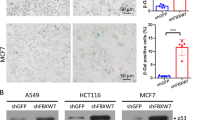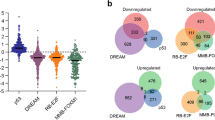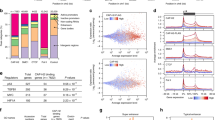Abstract
Cellular senescence is a permanent cell cycle arrest that can be triggered by a variety of stresses including short telomeres and activated oncogenes. Promyelocytic leukemia protein (PML) is a central component of the senescence response, and is able to trigger the process when overexpressed in human diploid fibroblasts (HDFs). Senescence induced by PML in HDFs is characterized by a modest increase in p53 levels and activity, the accumulation of hypophosphorylated Rb and a reduced expression of E2F-dependent genes. To dissect the p53 and Rb family requirements for PML-induced senescence, we used the oncoproteins E6 and E7 from human papillomavirus type 16. We found that the coexpression of E6 and E7 inhibited the growth arrest and senescence induced by PML. In addition, these viral oncoproteins blocked the formation of PML bodies and excluded both p53 and Rb from PML bodies. Expression of dominant-negative p53 alone failed to block PML-induced senescence and expression of E6 only delayed the process. On the other hand, expression of E7 was sufficient to block PML-induced senescence, while an E7 mutant unable to bind Rb did not. Together, these data indicate that PML-induced senescence engages the Rb tumor-suppressor pathway predominantly.
This is a preview of subscription content, access via your institution
Access options
Subscribe to this journal
Receive 50 print issues and online access
$259.00 per year
only $5.18 per issue
Buy this article
- Purchase on Springer Link
- Instant access to full article PDF
Prices may be subject to local taxes which are calculated during checkout







Similar content being viewed by others
References
Bischof O, Kirsh O, Pearson M, Itahana K, Pelicci PG and Dejean A . (2002). EMBO J., 21, 3358–3369.
Brehm A and Kouzarides T . (1999). Trends Biochem. Sci., 24, 142–145.
Brehm A, Miska EA, McCance DJ, Reid JL, Bannister AJ and Kouzarides T . (1998). Nature, 391, 597–601.
Brookes S, Rowe J, Ruas M, Llanos S, Clark PA, Lomax M, James MC, Vatcheva R, Bates S, Vousden KH, Parry D, Gruis N, Smit N, Bergman W and Peters G . (2002). EMBO J., 21, 2936–2945.
Campisi J . (2001). Trends Cell Biol., 11, S27–S31.
Chang BD, Watanabe K, Broude EV, Fang J, Poole JC, Kalinichenko TV and Roninson IB . (2000). Proc. Natl. Acad. Sci. USA, 97, 4291–4296.
Cohen N, Sharma M, Kentsis A, Perez JM, Strudwick S and Borden KL . (2001). EMBO J., 20, 4547–4559.
Damalas A, Kahan S, Shtutman M, Ben-Ze'ev A and Oren M . (2001). EMBO J., 20, 4912–4922.
Dannenberg JH, van Rossum A, Schuijff L and te Riele H . (2000). Genes Dev., 14, 3051–3064.
Dimri GP, Itahana K, Acosta M and Campisi J . (2000). Mol. Cell. Biol., 20, 273–285.
Dimri GP, Lee X, Basile G, Acosta M, Scott G, Roskelley C, Medrano EE, Linskens M, Rubelj I, Pereira-Smith O, Peacocke M and Campisi J . (1995). Proc. Natl. Acad. Sci. USA, 92, 9363–9367.
Ferbeyre G, de Stanchina E, Querido E, Baptiste N, Prives C and Lowe SW . (2000). Genes Dev., 14, 2015–2027.
Franco EL, Duarte-Franco E and Ferenczy A . (2001). Can. Med. Assoc. J., 164, 1017–1025.
Garkavtsev I and Riabowol K . (1997). Mol. Cell. Biol., 17, 2014–2019.
Gollahon LS, Kraus E, Wu TA, Yim SO, Strong LC, Shay JW and Tainsky MA . (1998). Oncogene, 17, 709–717.
Goodwin EC, Yang E, Lee CJ, Lee HW, DiMaio D and Hwang ES . (2000). Proc. Natl. Acad. Sci. USA, 97, 10978–10983.
Greider CW . (1998). Curr. Biol., 8, R178–R181.
Hahn WC, Dessain SK, Brooks MW, King JE, Elenbaas B, Sabatini DM, DeCaprio JA and Weinberg RA . (2002). Mol. Cell. Biol., 22, 2111–2123.
Haq R, Brenton JD, Takahashi M, Finan D, Finkielsztein A, Damaraju S, Rottapel R and Zanke B . (2002). Cancer Res., 62, 5076–5082.
Hara E, Smith R, Parry D, Tahara H, Stone S and Peters G . (1996). Mol. Cell. Biol., 16, 859–867.
Harley CB, Futcher AB and Greider CW . (1990). Nature, 345, 458–460.
Hayflick L and Moorhead PS . (1961). Exp. Cell Res., 25, 585–621.
Heidebrecht HJ, Buck F, Endl E, Kruse ML, Adam-Klages S, Andersen K, Frahm SO, Schulte C, Wacker HH and Parwaresch R . (2001). Lab. Invest., 81, 1163–1165.
Helt AM and Galloway DA . (2001). J. Virol., 75, 6737–6747.
Iwasa H, Han J and Ishikawa F . (2003). Genes Cells, 8, 131–144.
Kiyono T, Foster SA, Koop JI, McDougall JK, Galloway DA and Klingelhutz AJ . (1998). Nature, 396, 84–88.
Langley E, Pearson M, Faretta M, Bauer UM, Frye RA, Minucci S, Pelicci PG and Kouzarides T . (2002). EMBO J., 21, 2383–2396.
Lill NL, Grossman SR, Ginsberg D, DeCaprio J and Livingston DM . (1997). Nature, 387, 823–827.
Lin AW and Lowe SW . (2001). Proc. Natl. Acad. Sci. USA, 98, 5025–5030.
Macip S, Igarashi M, Fang L, Chen A, Pan ZQ, Lee SW and Aaronson SA . (2002). EMBO J., 21, 2180–2188.
Mantovani F and Banks L . (2001). Oncogene, 20, 7874–7887.
Medcalf AS, Klein-Szanto AJ and Cristofalo VJ . (1996). Cancer Res., 56, 4582–4585.
Melnick A and Licht JD . (1999). Blood, 93, 3167–3215.
Munger K, Basile JR, Duensing S, Eichten A, Gonzalez SL, Grace M and Zacny VL . (2001). Oncogene, 20, 7888–7898.
Nielsen SJ, Schneider R, Bauer UM, Bannister AJ, Morrison A, O'Carroll D, Firestein R, Cleary M, Jenuwein T, Herrera RE and Kouzarides T . (2001). Nature, 412, 561–565.
Palmero I, McConnell B, Parry D, Brookes S, Hara E, Bates S, Jat P and Peters G . (1997). Oncogene, 15, 495–503.
Pearson M, Carbone R, Sebastiani C, Cioce M, Fagioli M, Saito S, Higashimoto Y, Appella E, Minucci S, Pandolfi PP and Pelicci PG . (2000). Nature, 406, 207–210.
Peeper DS, Dannenberg JH, Douma S, te Riele H and Bernards R . (2001). Nat. Cell Biol., 3, 198–203.
Phelps WC, Yee CL, Munger K and Howley PM . (1988). Cell, 53, 539–547.
Rheinwald JG, Hahn WC, Ramsey MR, Wu JY, Guo Z, Tsao H, De Luca M, Catricala C and O'Toole KM . (2002). Mol. Cell. Biol., 22, 5157–5172.
Sage J, Mulligan GJ, Attardi LD, Miller A, Chen S, Williams B, Theodorou E and Jacks T . (2000). Genes Dev., 14, 3037–3050.
Salomoni P and Pandolfi PP . (2002). Cell, 108, 165–170.
Sedivy JM . (1998). Proc. Natl. Acad. Sci. USA, 95, 9078–9081.
Serrano M and Blasco MA . (2001). Curr. Opin. Cell Biol., 13, 748–753.
Serrano M, Lin AW, McCurrach ME, Beach D and Lowe SW . (1997). Cell, 88, 593–602.
Sherr CJ and DePinho RA . (2000). Cell, 102, 407–410.
Smogorzewska A and de Lange T . (2002). EMBO J., 21, 4338–4348.
Stott FJ, Bates S, James MC, McConnell BB, Starborg M, Brookes S, Palmero I, Ryan K, Hara E, Vousden KH and Peters G . (1998). EMBO J., 17, 5001–5014.
Wang W, Chen JX, Liao R, Deng Q, Zhou JJ, Huang S and Sun P . (2002). Mol. Cell. Biol., 22, 3389–3403.
Wells SI, Francis DA, Karpova AY, Dowhanick JJ, Benson JD and Howley PM . (2000). EMBO J., 19, 5762–5771.
Westbrook TF, Nguyen DX, Thrash BR and McCance DJ . (2002). Mol. Cell. Biol., 22, 7041–7052.
Xu HJ, Zhou Y, Ji W, Perng GS, Kruzelock R, Kong CT, Bast RC, Mills GB, Li J and Hu SX . (1997). Oncogene, 15, 2589–2596.
Young JI and Smith JR . (2001). J. Biol. Chem., 276, 19610–19616.
Acknowledgements
We specially thank Dr V Bourdeau, L Chatel-Chaix, Dr L DesGroseillers, Dr E Querido and Dr M Soengas for reviewing the manuscript, Dr Karl Munger for useful suggestions, Dr H-J Heidebrecht for the anti-Mcm6 antibody and Drs D Galloway and P Howley for plasmids and useful suggestions. This research was supported by Grant 86239 from the Canadian Institute of Health and Research.
Author information
Authors and Affiliations
Corresponding author
Supplementary information
Supplementary Figure S1
E7 induces cell death in HDFs. IMR90 cells expressing LXSN, E6, E7, or E6/E7 were infected with a PML-expressing retrovirus or a control vector. Cell death was scored 1 day after selection using Trypan blue staining (TIF 139 kb)
Supplementary Figure S2 and Table SI
Effects of individual expression of E6 and E7 on PML bodies. Cells bearing the control vector LXSN or its derivative containing E6 or E7 were infected with either another control vector or its derivatives expressing PML. PML bodies were visualized by indirect immunofluorescence using the anti-PML antibody PG-M3. Nuclei were counterstained with DAPI (TIF 2306 kb)
Rights and permissions
About this article
Cite this article
Mallette, F., Goumard, S., Gaumont-Leclerc, MF. et al. Human fibroblasts require the Rb family of tumor suppressors, but not p53, for PML-induced senescence. Oncogene 23, 91–99 (2004). https://doi.org/10.1038/sj.onc.1206886
Received:
Revised:
Accepted:
Published:
Issue Date:
DOI: https://doi.org/10.1038/sj.onc.1206886
Keywords
This article is cited by
-
Quantitative SUMO proteomics reveals the modulation of several PML nuclear body associated proteins and an anti-senescence function of UBC9
Scientific Reports (2018)
-
Senescence-associated ribosome biogenesis defects contributes to cell cycle arrest through the Rb pathway
Nature Cell Biology (2018)
-
Restoration of tumor suppression in prostate cancer by targeting the E3 ligase E6AP
Oncogene (2016)
-
PML-mediated signaling and its role in cancer stem cells
Oncogene (2014)
-
Temporally distinct roles for tumor suppressor pathways in cell cycle arrest and cellular senescence in Cyclin D1-driven tumor
Molecular Cancer (2012)



